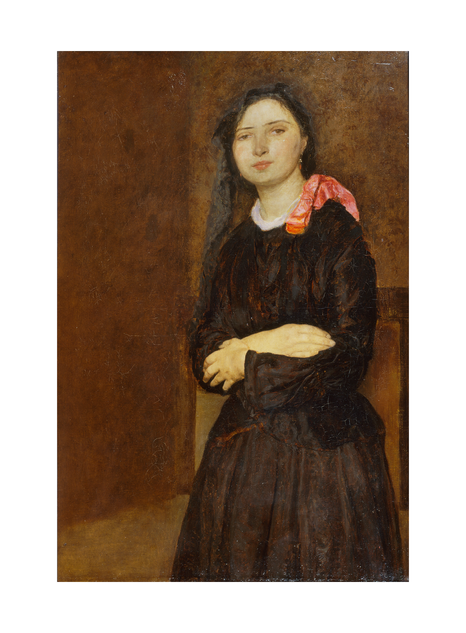Squashed, egg-like face. Floppy, bubble-gum pink bow. Arms loosely crossed over her stomach, awkwardly held. Perfect Rembrandt-esque hands and smooth-as-silk cheeks. Dorelia stands, drifting to the left, in a space so anonymous it hardly looks like space at all. The shadowy suggestion of a corner is all that keeps her from floating out to stand beside us. She is enigmatic to her core, impossible to read but deeply specific. She stares straight past us, the viewers, at the woman painting her: Gwen John.
John is known for being a loner, a characterisation that arose in part from her tendency to paint empty spaces or solitary women. Many of the women she painted have illegible or nondescript faces, serving more as explorations in texture and colour than as images of real people. By contrast this early painting, made between 1903 and 1904, shows a particular and special friend. Featured in a new exhibition at Pallant House Gallery in Chichester this spring, Dorelia in a Black Dress is a portrait of Dorothy “Dorelia” McNeill. To spend time looking at Dorelia here is to reveal the way John’s life was fundamentally shaped by impassioned relationships and rich social networks, teaching us that you can enjoy solitude while still treasuring your friends.
John and Dorelia became friends while both still art students in London, with John at the Slade and Dorelia at the Westminster School of Art. In the summer of 1903, they set off to walk from London to Rome, making it down as far as Toulouse in the south of France. Along the way they earned their keep in inns by drawing portraits of the landlords and their fellow customers. Some nights, they slept outside.
Besides a desire for adventure and escape, the trip was also intended to put some distance between Dorelia and John’s younger brother Augustus, also a renowned painter of the time, who had fallen in love with her in the winter of 1903. Inconveniently, Augustus was already married to Gwen’s close friend Ida.
The resolution to this love triangle has since become famous: Augustus and Ida decided to invite Dorelia to join their marriage, creating a ménage à trois that lasted from the summer of 1904 until Ida’s death from childbirth complications in 1907, by which point there were seven children between them. But perhaps the triangle first began as a square, with the fourth corner being John herself.
It is clear from John’s letters that she had romantic relationships with men and women throughout her life. Her relationship with Dorelia has never been confirmed as sexual, but to me their close, one-on-one friendship, forged before and during their trip to France, speaks to something special and passionate between them. Friendship can be a romance, too.
In any case, the depth of her feelings for Dorelia are there in this painting: the careful, slippery way she gives texture to the black dress, the inscrutability and timelessness of the space Dorelia occupies, the hesitance of her stance, the locked gaze between subject and artist. And in the works that follow, over the next three decades of Gwen’s life, this scrutiny of women’s interior selves and their bodies remained the bedrock of her artistic practice. The intensity of her artistic gaze is what makes her paintings so captivating, and what keeps me coming back to them again and again.
Gwen John: Art and Life in London and Paris is on display at Pallant House Gallery, Chichester, until 8th October














